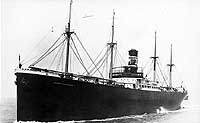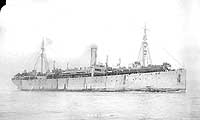
A widely-used scheme for identifying merchant-type ships (including Naval vessels with merchant ship characteristics) is the Mast-Kingpost-Funnel Coding system. This describes a ship by its arrangement of masts, kingposts, and funnels (smokestacks). The Online Library uses a version of this system, with some additions to indicate particular features that might otherwise prove confusing.
There is a vast potential variety of arrangements coded under this system. Some examples of coding are:
Caution: Arrangements of masts, funnels and kingposts frequently change during an individual ship's career. A situation commonly encountered is a kingpost that has "grown" into a mast, or vice versa. Some features can be difficult to see, for example short kingposts which are simply "lost" in a ship's topside clutter or are hidden by other structures at some angles of view. Seen from the side, singly installed kingposts can be easily mistaken for kingpost pairs, and vice versa. Some funnels are oddly shaped, or small, and may be difficult to identify as such. Light masts, fitted amidships for signalling or affixed atop kingposts, may come and go during a ship's life and, when fitted, may not be very visible. Approach any ship identification task with these considerations firmly in mind!
This page features an explanation of the system of mast, kingpost and funnel (smokestack) coding used for identification of merchant ships, with appropriate illustrations.
| If you want higher resolution reproductions than the digital images presented here, see: "How to Obtain Photographic Reproductions." |
Click on the small photograph to prompt a larger view of the same image.
|
"M-F-M" ARRANGEMENT Seen on USS Tenedores, 1918. |
 Picture Data |
|
"M-M-F-M-M" ARRANGEMENT Seen on S.S. Edgar F. Luckenbach, circa 1916. |
 Picture Data |
|
"M-K-F-K-M" ARRANGEMENT Seen on USS Iowan, 1919. |
 Picture Data |
|
"K-KM-K-F-K-KM-K" ARRANGEMENT Seen on USS South Bend, 1919. |
 Picture Data |
|
"KS-KF-M-K-KS" ARRANGEMENT Seen on USS Independence, 1918. NOTE: As an example of the difficulty in distinguishing kingpost pairs ("K") from single ("KS") kingposts, when ships are seen from the side, see: Photo # NH 70472, which also shows USS Independence. |
 Picture Data |
| If you want higher resolution reproductions than the digital images presented here, see: "How to Obtain Photographic Reproductions." |
Page made 18 March 2007